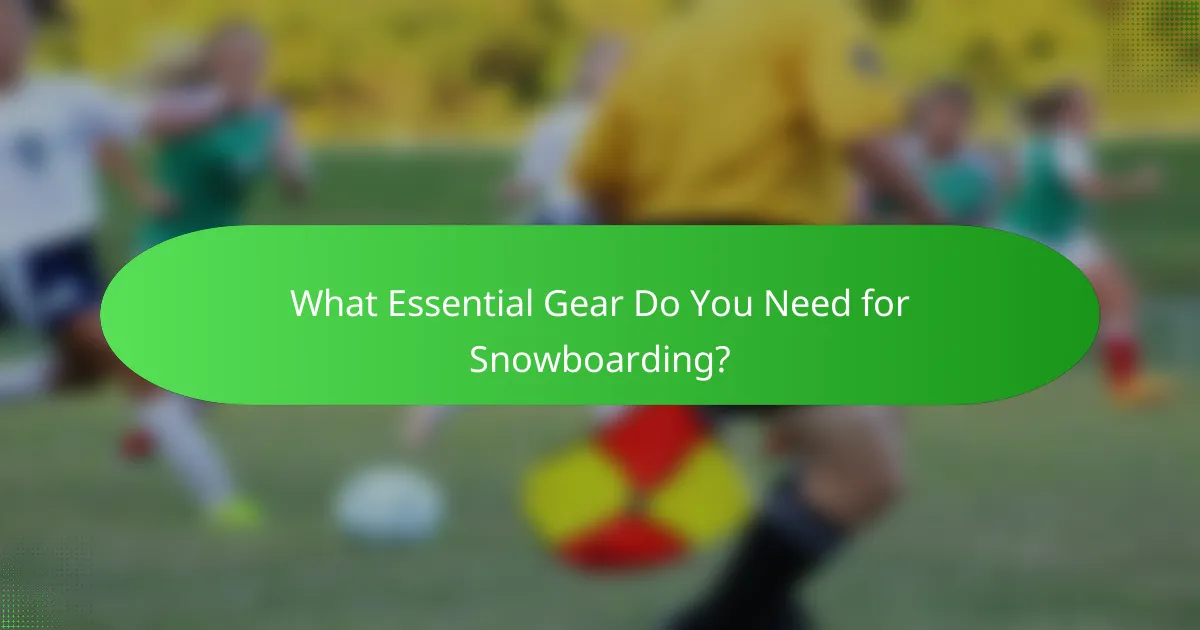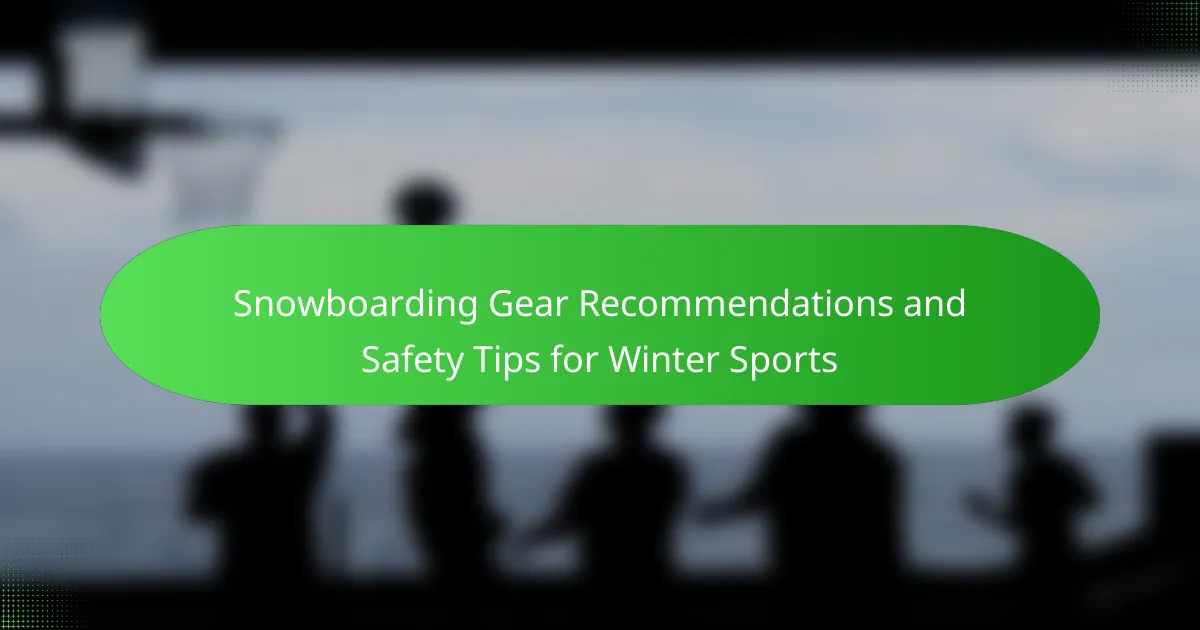Snowboarding requires the right gear and safety measures to ensure an enjoyable experience on the slopes. Essential equipment includes a snowboard, boots, bindings, helmet, goggles, and appropriate clothing. Safety gear like wrist guards and knee pads helps prevent injuries. Understanding regional factors and adhering to safety guidelines further enhances your snowboarding adventure.

What Essential Gear Do You Need for Snowboarding?
To snowboard safely and effectively, essential gear includes a snowboard, boots, bindings, helmet, goggles, and appropriate clothing. Each item plays a critical role in performance and safety on the slopes.
The snowboard should match your skill level and riding style, while boots must fit snugly for control. Bindings connect the boots to the board, ensuring stability. A helmet protects your head from injuries, and goggles provide visibility in various weather conditions. Layered clothing, including moisture-wicking base layers and insulated outerwear, keeps you warm and dry.
Investing in quality gear enhances your snowboarding experience, promoting safety and comfort.
How to Choose the Right Snowboard for Your Style?
To choose the right snowboard for your style, consider your skill level, riding style, and terrain preferences. Beginners should opt for softer boards that provide easier control, while advanced riders may prefer stiffer boards for better stability at high speeds.
Evaluate the snowboard’s length, which should typically reach between your chin and nose, depending on your riding style. All-mountain boards are versatile for various terrains, while freestyle boards are shorter and lighter for tricks.
Check the board’s shape; directional boards are best for powder, while twin-tip boards are ideal for park riding. Lastly, consider the flex rating to match your riding style; softer flex is better for beginners and park riders, while stiffer flex suits aggressive riders.
Which Bindings Offer the Best Performance?
The best performance bindings for snowboarding include models that emphasize responsiveness, comfort, and durability. High-end options like the Burton Cartel, Union Force, and K2 Lien AT excel in these areas, providing optimal energy transfer and support.
Bindings such as the Burton Cartel feature a medium flex that balances control and playfulness, while the Union Force offers a robust construction for all-mountain versatility. The K2 Lien AT stands out with its unique tool-less adjustability, enhancing user convenience.
When selecting bindings, consider factors like weight (e.g., lightweight designs improve maneuverability) and compatibility with your snowboard type (e.g., freestyle vs. all-mountain).
What Types of Boots Should You Consider?
Consider all-mountain, freestyle, and backcountry boots for snowboarding. All-mountain boots offer versatility for various terrains. Freestyle boots are softer, enhancing maneuverability for tricks. Backcountry boots prioritize lightweight design and walk mode for hiking. Each type caters to specific riding styles, ensuring optimal performance and comfort.
How to Select Appropriate Outerwear for Different Conditions?
Select outerwear based on weather conditions and activity level. For snowboarding, prioritize insulation, waterproofing, and breathability.
1. **Cold and Dry Conditions**: Choose insulated jackets with waterproof shells. Look for features like adjustable hoods and cuffs for warmth.
2. **Wet and Mild Conditions**: Opt for waterproof, breathable jackets. Consider options with ventilation zippers to manage body heat.
3. **Windy Conditions**: Select windproof outerwear with a snug fit to reduce wind chill. Layering is essential for flexibility.
4. **Extreme Cold**: Invest in heavy-duty insulated gear with thermal lining. Ensure it has a high waterproof rating to withstand snow and moisture.

What Safety Equipment is Necessary for Snowboarding?
Essential safety equipment for snowboarding includes a helmet, wrist guards, knee pads, and impact shorts. These items protect against common injuries during falls and collisions.
1. Helmet: Protects the head from impact.
2. Wrist guards: Prevent wrist injuries from falls.
3. Knee pads: Cushion and support the knees.
4. Impact shorts: Shield the hips and tailbone.
Investing in quality gear enhances safety and confidence on the slopes.
Why is a Helmet Crucial for Snowboarders?
A helmet is crucial for snowboarders as it protects against head injuries during falls or collisions. Snowboarding involves high speeds and challenging terrains, increasing the risk of accidents. Helmets significantly reduce the severity of head trauma, making them essential safety gear. Research shows that wearing a helmet can decrease the risk of head injury by up to 60%. Additionally, modern helmets often include features like ventilation and impact resistance, enhancing comfort and safety. Prioritizing helmet use can lead to safer snowboarding experiences.
What Protective Gear Can Help Prevent Injuries?
Wearing appropriate protective gear can significantly reduce the risk of injuries while snowboarding. Essential items include helmets, wrist guards, knee pads, and padded jackets. Helmets protect against head injuries, while wrist guards prevent fractures. Knee pads offer cushioning for falls, and padded jackets enhance overall safety. Investing in high-quality gear tailored to fit properly is crucial for effective protection.
How to Choose the Right Goggles for Visibility and Protection?
To choose the right goggles for visibility and protection, prioritize features like lens tint, anti-fog coating, and fit. Look for lenses that enhance contrast in snowy conditions, such as rose or yellow tints. Anti-fog coatings prevent moisture buildup, ensuring clear vision. A comfortable fit with adjustable straps is essential for long sessions on the slopes. Consider UV protection as a vital attribute, as it shields eyes from harmful rays.

Which Factors Influence Snowboarding Gear Choices by Region?
Regional factors such as climate, terrain, and local culture significantly influence snowboarding gear choices. For instance, colder regions may prioritize insulation and waterproof materials, while areas with varied terrain might focus on versatility and durability. Additionally, cultural preferences can shape brand loyalty and style choices among snowboarders.
How Do Weather Conditions Impact Gear Selection?
Weather conditions significantly influence gear selection for snowboarding. For optimal performance and safety, consider the following factors:
1. **Temperature**: Choose insulated gear for cold conditions; lighter options are suitable for milder weather.
2. **Precipitation**: Waterproof outer layers are essential in wet conditions to keep you dry.
3. **Wind**: Windproof jackets can protect against chill and improve comfort during high winds.
4. **Visibility**: Goggles with interchangeable lenses help adapt to varying light conditions, enhancing visibility.
5. **Snow Conditions**: Hard-packed snow may require different board types than powder; select gear accordingly.
Understanding these elements ensures you select appropriate gear, enhancing your snowboarding experience and safety.
What Local Trends Affect Gear Preferences?
Local trends significantly influence snowboarding gear preferences. Factors such as regional climate, snow conditions, and local culture shape what riders choose. For example, areas with heavy snowfall may favor wider boards for powder, while urban settings might lean towards more versatile, all-mountain gear. Additionally, local events and community recommendations often drive brand popularity and gear selection. Understanding these trends helps snowboarders select equipment that suits their environment and enhances their experience on the slopes.

What Are the Best Practices for Snowboarding Safety?
To ensure safety while snowboarding, wear appropriate gear, follow guidelines, and stay aware of your surroundings. Essential gear includes a helmet, goggles, and wrist guards. Check weather conditions and choose suitable trails. Always ride with a buddy and maintain a safe distance from others. Be mindful of your speed and terrain. Additionally, consider taking lessons to enhance your skills. Adhering to these practices can significantly reduce the risk of injury.
How to Assess Your Skill Level for Safe Riding?
To assess your skill level for safe riding, consider your experience, comfort on various terrains, and ability to control speed. Evaluate your proficiency in turning, stopping, and navigating obstacles. Seek feedback from instructors or experienced riders to identify areas for improvement.
What Techniques Can Improve Your Safety on the Slopes?
To improve safety on the slopes, invest in quality snowboarding gear and follow essential safety tips. Properly fitted helmets protect against head injuries, while wrist guards can prevent fractures. Always check weather conditions and visibility before heading out.
1. Wear a helmet to minimize head injury risks.
2. Use wrist guards to protect against falls.
3. Check equipment for proper function before use.
4. Stay hydrated and take breaks to avoid fatigue.
5. Follow slope signs and guidelines for safety.
Why is It Important to Follow Resort Guidelines?
Following resort guidelines is crucial for safety and enjoyment during winter sports. These guidelines ensure proper use of snowboarding gear, minimizing risks of injury. Adhering to rules helps maintain a safe environment for all participants. Moreover, following guidelines can enhance the overall experience by promoting responsible behavior on the slopes.

What Common Mistakes Should You Avoid When Snowboarding?
To avoid common mistakes when snowboarding, focus on proper gear, technique, and safety. Ensure your equipment fits well and is appropriate for your skill level. Many beginners overlook the importance of warm-up exercises, which can lead to injuries. Always check weather conditions and terrain before heading out. Additionally, don’t forget to practice falling safely to minimize injury risk.
How to Prevent Gear Malfunctions on the Slopes?
To prevent gear malfunctions on the slopes, ensure regular maintenance and proper usage of your snowboarding equipment. Inspect bindings, check for wear on the board, and use appropriate wax for conditions.
1. Regularly check bindings for tightness and functionality.
2. Store gear in a dry place to prevent rust and damage.
3. Use the right wax for snow conditions to enhance performance.
4. Avoid using damaged equipment; replace worn-out parts promptly.
These practices will enhance safety and performance while snowboarding.
What Are the Risks of Ignoring Safety Equipment?
Ignoring safety equipment while snowboarding significantly increases the risk of injury. Essential gear like helmets, wrist guards, and knee pads protect against falls and collisions. Statistics show that snowboarders wearing helmets reduce head injury risk by 60%. Without proper safety equipment, injuries can range from minor bruises to severe concussions or fractures. Investing in quality gear not only enhances safety but also improves overall performance and confidence on the slopes.
How to Stay Within Your Skill Level to Ensure Safety?
Stay within your skill level by choosing appropriate snowboarding gear and practicing safe techniques. Select a board that matches your experience, such as a softer flex for beginners. Always wear a helmet and protective gear to minimize injury risks. Familiarize yourself with the terrain and conditions before attempting new runs. As a result, you can enjoy snowboarding while ensuring your safety.
What Expert Tips Can Help Enhance Your Snowboarding Experience?
To enhance your snowboarding experience, invest in high-quality gear and prioritize safety. Choose a well-fitted helmet to protect your head, and wear layered clothing for warmth and flexibility. Use snowboards suited to your skill level and terrain, ensuring they have appropriate features like rocker or camber profiles. Regularly check your bindings for security and adjust them for comfort. Always carry essential safety gear, such as a first aid kit and avalanche beacon when in backcountry areas. Familiarize yourself with the mountain layout and stay within your ability level to avoid accidents.
